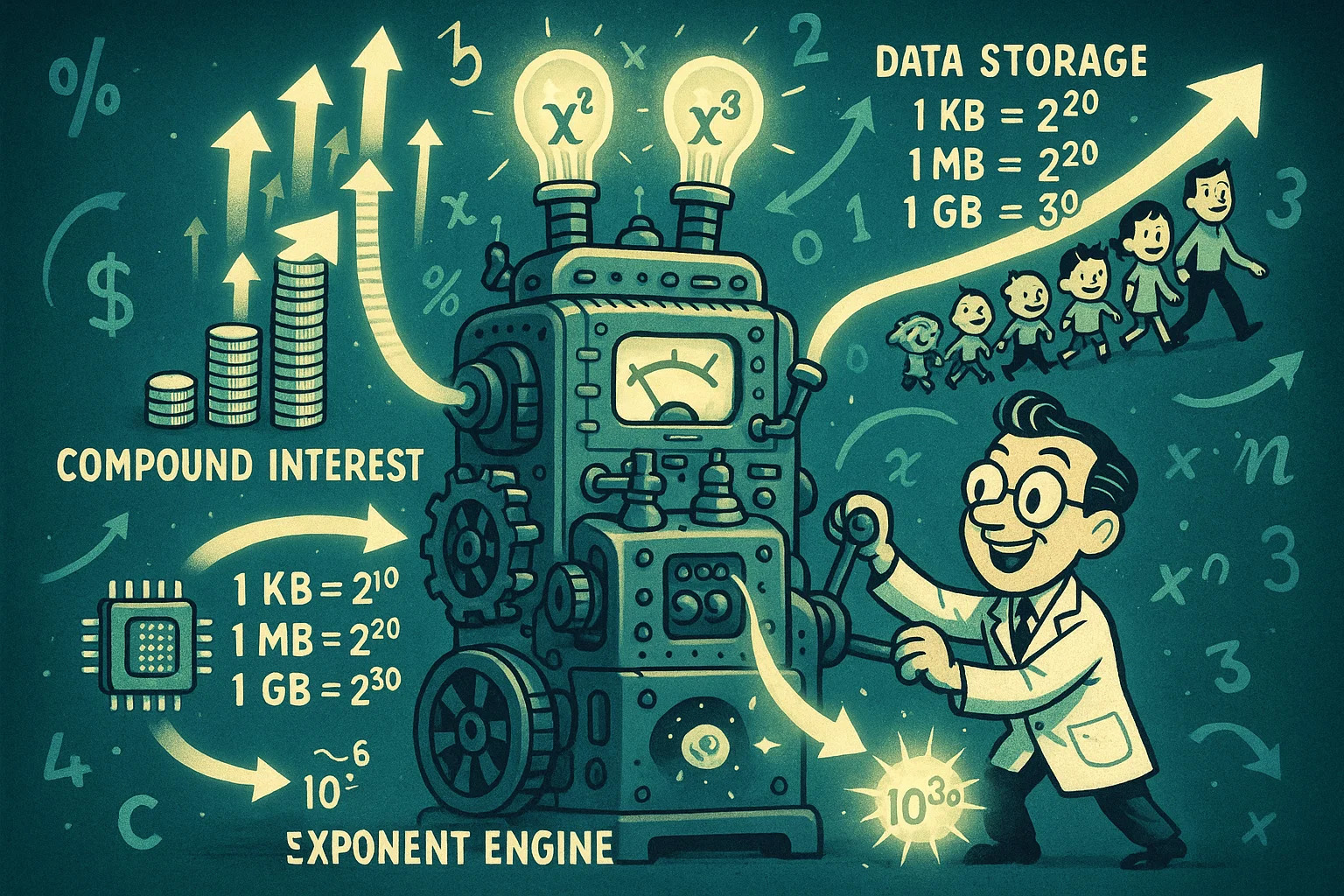What is Exponents
Exponents are one of those math concepts that look intimidating at first but quickly become second nature once you see how they work. At their core, exponents are just a shortcut — a compact way of writing repeated multiplication. Instead of writing 2 × 2 × 2, you can write 2³, which simply means 2 multiplied by itself three times. The little number (called the “power” or “exponent”) tells you how many times the base is used as a factor.
For example:
-
5²means5 × 5 = 25. -
10³means10 × 10 × 10 = 1,000. -
Even fractions and negatives can have exponents, like
(-3)² = 9.
Exponents pop up everywhere — in science equations, compound interest in finance, and even when measuring things like population growth or computing power. They’re not just for high school math; they’re part of how we describe the world in numbers every day.
💁♀️ Did you know? The term “googol,” a 1 followed by 100 zeros (10¹⁰⁰), was coined by a 9-year-old in 1938. It’s so big that it inspired the name for Google, whose search engines handle exponentially growing amounts of data every day.
How Exponents Show Up in Everyday Math
Exponents aren’t just something you bump into in math class — they’re tucked into the background of a lot of things we use every day. Whenever numbers grow or shrink really fast, chances are there’s an exponent behind it.
Take compound interest, for example. If you leave $1,000 in a savings account that earns 5% interest per year, the amount grows exponentially — meaning your money doesn’t just grow by the same amount each year, it grows faster and faster because you’re earning interest on both the original amount and the interest from previous years. The formula banks use? It’s filled with exponents, and tools like a Compound Interest Calculator can help you see exactly how those numbers climb over time.

Or consider computers and data. Computer storage and processing speeds often double over time (think Moore’s Law), and those growth rates are easiest to describe with powers of two:
-
1 KB = 2¹⁰ bytes (1,024 bytes)
-
1 MB = 2²⁰ bytes
-
1 GB = 2³⁰ bytes
Even things like population growth use exponents. If a city’s population grows 2% each year, it doesn’t add the same number of people each year — it compounds. After a decade, the math shows a much bigger jump than you’d expect from a simple add-up.
And then there’s science. Exponents are everywhere in physics, chemistry, and biology — from measuring microscopic cells (10⁻⁶ meters) to describing the energy released by stars (10³⁰ joules). They let us work with unimaginably big and small numbers without writing out endless zeros.
🔎 Fun fact: The speed of light is roughly 3 × 10⁸ meters per second. Writing it out as 300,000,000 meters per second is possible, but using exponents makes calculations (and your notes) a lot cleaner.
Quick Rules to Make Exponents Easy
At first glance, exponents can feel like a puzzle, but there are a few simple patterns that make them click quickly. Most of the time, you don’t need to memorize dozens of formulas — just a handful of rules that cover almost every situation you’ll see.
1. Multiplying powers with the same base
If the base is the same, you just add the exponents: 2³ × 2² = 2⁵ = 32.
This rule saves time because it avoids writing out all the multiplication.
2. Dividing powers with the same base
If you’re dividing, subtract the exponents: 5⁶ ÷ 5² = 5⁴ = 625.
3. Power raised to another power
When you see something like (3²)³, you multiply the exponents: (3²)³ = 3⁶ = 729.
4. Negative exponents
A negative exponent doesn’t make the number negative — it flips it into a fraction: 2⁻³ = 1 / 2³ = 1/8.
This trick is especially handy when dealing with scientific notation or very small numbers.
5. Fractional exponents
These represent roots. A ½ exponent means a square root: 9^(1/2) = √9 = 3. A ⅓ exponent means a cube root, and so on.
Once you know these, combining and simplifying exponents becomes way less intimidating. And if you’re juggling really big or tiny numbers, scientific notation (which uses exponents) helps keep things tidy.
Big Numbers Without the Headache
Sometimes, numbers get so massive (or tiny) that writing them out feels impossible. That’s where exponents come in — they’re the shortcut that keeps math manageable.
Take the distance from Earth to the Sun, for example. It’s about 149,600,000 kilometers. Instead of writing all those zeros, scientists write it as 1.496 × 10⁸ km. The exponent (8) shows how many places to move the decimal point, which keeps calculations tidy when those numbers get even larger.
This isn’t just for space and science. Scientific notation — which is built entirely on exponents — is used everywhere from chemistry labs to computer programming. Whenever we deal with particle sizes (like a virus, around 1 × 10⁻⁷ meters) or massive data counts, exponents keep things practical.
Even calculators (including online ones) use exponents to handle calculations beyond what you can do by hand. For example, try calculating 9²⁰. The answer is over 121 trillion, and it’s far easier to read in scientific notation than as a string of digits.
And for anyone curious about real-world math applications, tools like the Math Calculator can help with general problem-solving when exponents start blending into other equations.


